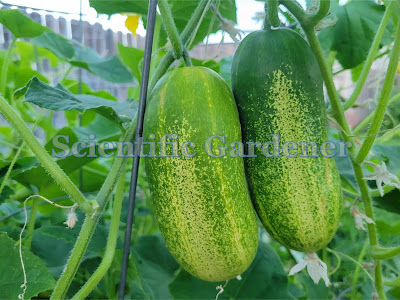One of the most impressive cucumber varieties that I grew in my parthenocarpic cucumber greenhouse trial was the Monika. Back when I tried them, the vines were productive and completely gynoecious – producing only female flowers that resisted changing color or aborting the female flowers.
Due to their success in the greenhouse, I figured it might be interesting growing the Monika out for seed in the fertile garden. Similar to growing in the greenhouse, the vines were highly productive – at least with female flowers. While not every female flower set fruit, the majority did – and those that didn’t primarily didn’t because the other fruit set was so heavy. Despite how great the production was, there was no male flower to be seen. Productive seedless cucumbers are a boon to growers, but a significant bane to seed growers. Without pollen from male flowers, all the female fruit will produce either seedless fruit or fruit with seed that is not viable. The male flowers probably did not appear anywhere on the vines until 3-4 weeks after the female flowers. In face, it took until half way through a second harvest until a few male flowers began to develop. While I am not in favor of genetic engineering or messing with nature too much, it would have been really nice to have some kind of hormone that I could spray on the plants to increase the incidence of male flowers.
Once male flowers finally began developing, there were plenty of fruit on the vine that needed to be harvested. With all the abundance of Monika cucumbers, I decided to try my hand at pickling. Pickling is definitely not my forté and the mix I used to prepare the pickles made a brine that did not suit myself or my family. We ended up getting rid of the pickles after consuming only a jar or so.
After the pickling failure – failing by using a store-bought pre-made recipe – I continued caring for the remaining Monika cucumbers. They were so productive. Honestly, Monika was definitely a favorite to grow for fruit – but not for seed.
Anyone who has grown parthenocarpic cucumber varieties knows that they require a large population and many male flowers in order to ensure proper pollination. Even then, harvests of varieties like English Telegraph can be dismal. My harvest was more than the ten gallons pictured, but it was enough. In the end, I was satisfied to collect harvest enough seed from the fruit to last me into the next season.




































No comments:
Post a Comment
Dear Gardening Friends,
I look forward to learning more about gardening with you. Your comments help me recognize that gardening is a life-long journey.
To advertisers: Note that this blog is concerned with gardening and gardening techniques. Please do not attempt to advertise here by leaving a comment. Depending upon how egregious the comment is, it may be deleted.